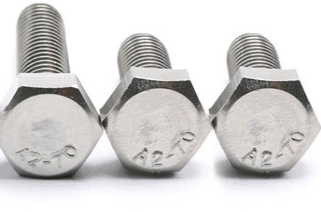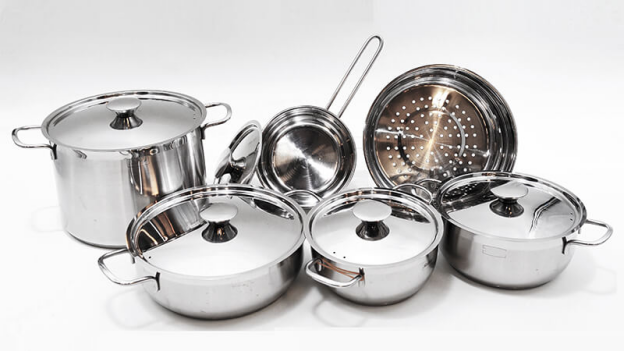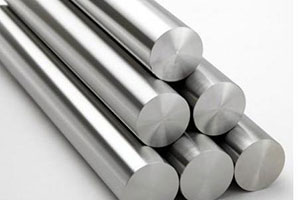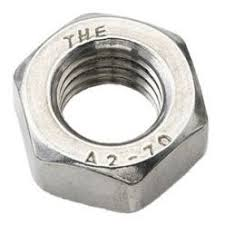A2-70 Stainless Steel vs 18-8: Choosing the Right Material
 Jun 17,2024
Jun 17,2024

Marine grade A2-70 stainless steel is best for applications where high tensile strength is required. 18-8 stainless steel has high corrosion resistance and is used in applications where ease of fabrication and cost are the priorities. In this article, you will get in-depth knowledge of the difference between A2-70 and 18-8 duplex stainless steels so you can choose correctly for your application.
A2-70 Stainless Steel
The duplex stainless-steel type named A2-70 which is also known as austenitic stainless steel. 304 stainless steels from 300 series are the other designation of A2-70. Stainless steel A2-70 contains 17-19% chromium, 2% magnesium, and 8-10% nickel. This A2 stainless steel is acid-proof stainless steel and has high tensile strength. ;The A2-70 stainless steel is defined standardly as ISO 3506-1.

A2-70 stainless steel fasteners.
18-8 Stainless Steel
From the 300 series of stainless steel, 304 stainless also named 18-8 stainless steel is best known for its ease of fabrication and corrosion protection. 18-8 duplex stainless is austenitic stainless steel containing 8 percent nickel and 18 percent chromium. 18-8 stainless grade is cost-effective, and its standard designation is AISI 304.

18-8 stainless steel crockery.
YouTube video explaining the difference between A2-70 and 18-8 stainless steel.
Is 18-8 stainless steel the same as A2?
YES! 18-8 stainless steel and A2-70 stainless steel both are the same which are 304 stainless steel from the 300 series of stainless steel. It contains 18% chromium and 8 % nickel.
What Are the Common Forms of 18/8 and A2-70 Stainless Steel Material?
Common forms for 18-8 stainless steel include:
- Tubes
- Sheets
- Pipes
- Fittings
- Wire
- Plates
- Bars

18-8 stainless steel rods.
Common forms for A2-70 stainless steel include
- Bolts
- Washers
- Threaded rods
- Nuts
- Screws

A2-70 stainless steel nut.
Advantages and Disadvantages 18-8 and A2-70
The pros and cons of 18-8 and A2-70 stainless steel are discussed below.
Pros of 18-8 stainless steel:
- High corrosion resistance in acidic as well as chlorine environments.
- Can provide corrosion resistance even at high-temperature applications due to excellent temperature resistance.
- Good for pharmaceutical and food applications due to hygiene properties.
- Ease of fabrication.
Cons of 18-8 stainless steel:
- At very extreme corrosion resistance like marine 18-8 stainless steel doesn't provide enough corrosion resistance.
- Is not magnetic.
- Can undergo stress corrosion cracking under extreme tensile fatigue and chlorine environment.
Pros of A2-70 stainless steel:
- Has high strength.
- Suitable for marine application due to good corrosion resistance plus good mechanical properties.
- Good for hardware application due to high mechanical properties like stainless steel fasteners.
Cons of A2-70 stainless steel:
- Poor resistance to high temperatures.
- Become brittle at low temperatures.
- Expensive compared to 18-8 stainless steel.
Applications and Parts: 18-8 vs A2-70 Stainless Steel
Common applications for 18-8 and A2-70 austenitic stainless steels are Outdoor furniture, fixtures, medical equipment, architectural elements, cutlery, and kitchen equipment.
18-8 stainless steel parts
- Storage tanks
- chemical containers
- piping and tubing
- Refrigerators
- Dishwashers
- Washing machines
- Surgical instruments
- medical implants
- diagnostic equipment
- Sinks
- Cookware
- Utensils
- food processing equipment
A2-70 stainless steel parts
- Bolts
- Screws
- Nuts
- Shafts
- Gears
- Bearings
- Springs
- Washers
- Threaded rods
18-10 and A2-70 Stainless Steel: Chemical Composition
The comparison of the chemical composition of 18-10 and A2-70 austenitic stainless steels is given below:
|
Element |
18-10 Stainless Steel (304) |
A2-70 Stainless Steel |
|
Carbon (C) |
≤ 0.08% |
≤ 0.12% |
|
Silicon (Si) |
≤ 1.00% |
≤ 2.00% |
|
Manganese (Mn) |
≤ 2.00% |
≤ 2.00% |
|
Phosphorus (P) |
≤ 0.045% |
≤ 0.045% |
|
Sulfur (S) |
≤ 0.030% |
≤ 0.030% |
|
Chromium (Cr) |
18.0% - 20.0% |
17.0% - 19.0% |
|
Nickel (Ni) |
8.0% - 10.5% |
8.0% - 10.5% |
YouTube video explaining the difference between 18-8 and 18-10 stainless steel.
AISI A2-70 stainless steel vs 18-8: Corrosion Resistance
AISI A2 70 stainless steel and ISO 3506-1 (18-8) stainless steel both have high corrosion resistance. AISI A2 70 stainless steel is used for general corrosion resistance applications but is suitable for marine applications due to its high mechanical properties. 18-8 stainless steel is used for specific corrosion resistance applications.
18 8 vs A2-70 Stainless: Physical Properties
The physical properties of 18-8 and A2-70 are compared below. Both have the same physical properties because have chemical composition almost the same.
Density
AISI A2 70 stainless steel and ISO 3506-1 (18-8) stainless steel have the same density due to the same chemical composition which is 8.00 g/cm³.
Melting Point
AISI A2 70 stainless steel and ISO 3506-1 (18-8) stainless steel have the same melting point of 1400-1450°C because primarily belong to the 300 stainless steel series.
Magnetism
AISI A2 70 stainless steel and ISO 3506-1 (18-8) stainless steel both don’t show magnetism when annealed but show slight magnetism when cold work.
Thermal Conductivity
AISI A2 70 stainless steel and ISO 3506-1 (18-8) stainless steel both have the same thermal conductivity due to the same chemical makeup of 16.2 W/m·K at 100°C.
Coefficient of Thermal Expansion
AISI A2 70 stainless steel and ISO 3506-1 (18-8) stainless steel both also have the same 17.2 x 10⁻⁶ /°C (9.6 x 10⁻⁶/°F) from 0 to 100°C.
Electrical Resistivity
AISI A2 70 stainless steel and ISO 3506-1 (18-8) stainless steel both have the same electrical resistivity of 0.72 x 10⁻⁶Ω·m.
18-8 vs A2-70 Stainless Steel: Mechanical Properties
Mechanical properties of 18-8 and A2-70 are compared below:
Tensile strength
18-8 Stainless Steel has a tensile strength of 620 N/mm² while for A2-70 stainless steel has 700 MPa.
Yield strength
18-8 Stainless Steel has a yield strength of 240 MPa while A2-70 stainless steel has 450 MPa.
Compressive strength
The compressive strength is the same as the tensile strength due to the isotropic nature of A2-70 and 18-8 Stainless Steel.
Shear strength
18-8 Stainless Steel has a shear strength of 359 N/mm² while for A2-70 stainless steel has 406 MPa.
Young's modulus
18-8 Stainless Steel has Young's modulus of 193 GPa while for A2-70 stainless steel also has Young's modulus of 193 GPa.
Shear modulus
18-8 Stainless Steel has a shear modulus of 77 GPa while for A2-70 stainless steel also has Young's modulus of 77 GPa.
Fracture toughness
A2-70 and 18-8 Stainless Steel has a fracture toughness of 50-150 MPa·√m which may vary depending upon heat treatments.
Elongation
18-8 Stainless Steel has an elongation of 40-50% in 50mm while for A2-70 stainless steel elongation is 20% in 50mm.
Impact strength
A2-70 stainless steel has high impact strength compared to 18-8 stainless steel because has high tensile strength compared to 18-8 stainless steel.
Resilience modulus
Both have high resilience modulus due to high toughness but A2-70 has slightly greater than 18-8 stainless steel.
Machinability
18-8 stainless steel shows the ease of machinability compared to A2-70 stainless steel because A2-70 stainless steel is hard and has high tensile strength.
Differences Between A2-70 and 18-8 Stainless Steel
Differences Between A2-70 and 18-8 Stainless Steel are compared below in table.
|
Property |
A2-70 Stainless Steel |
18-8 Stainless Steel |
|
Composition |
17-19% chromium, 8-10% nickel, 2% manganese |
18% chromium, 8% nickel |
|
Tensile Strength |
700 MPa (101,500 psi) |
620 N/mm² (90,000 psi) |
|
Yield Strength |
450 MPa |
240 MPa |
|
Corrosion Resistance |
Excellent in atmospheric, chemical, and marine environments |
Excellent in various applications, including food processing, medical devices, and architecture |
|
Applications |
High-strength and durability applications, such as aerospace and automotive components, fasteners, bolts, and screws |
General applications requiring corrosion resistance, such as kitchen equipment, medical devices, and architectural elements |
|
Cost |
Generally, more expensive than 18-8 stainless steel |
More cost-effective compared to A2-70 |
Is A2-70 or 18-8 Stainless Steel Better
A2-70 or 18-8 Stainless Steel both have unique properties that's why are better for specific applications. For applications where high tensile strength and corrosion resistance are required, A2-70 is the best choice like marine applications. For applications where specific high corrosion resistance and ease of fabrication is required 18-8 stainless steel is better.
 Tel/WeChat:
Tel/WeChat:  Email:
Email: 
 Home
Home
 18/10 Stainless Steel: A Comprehensive Guide for Mechanical Engineers and Designers
18/10 Stainless Steel: A Comprehensive Guide for Mechanical Engineers and Designers 







